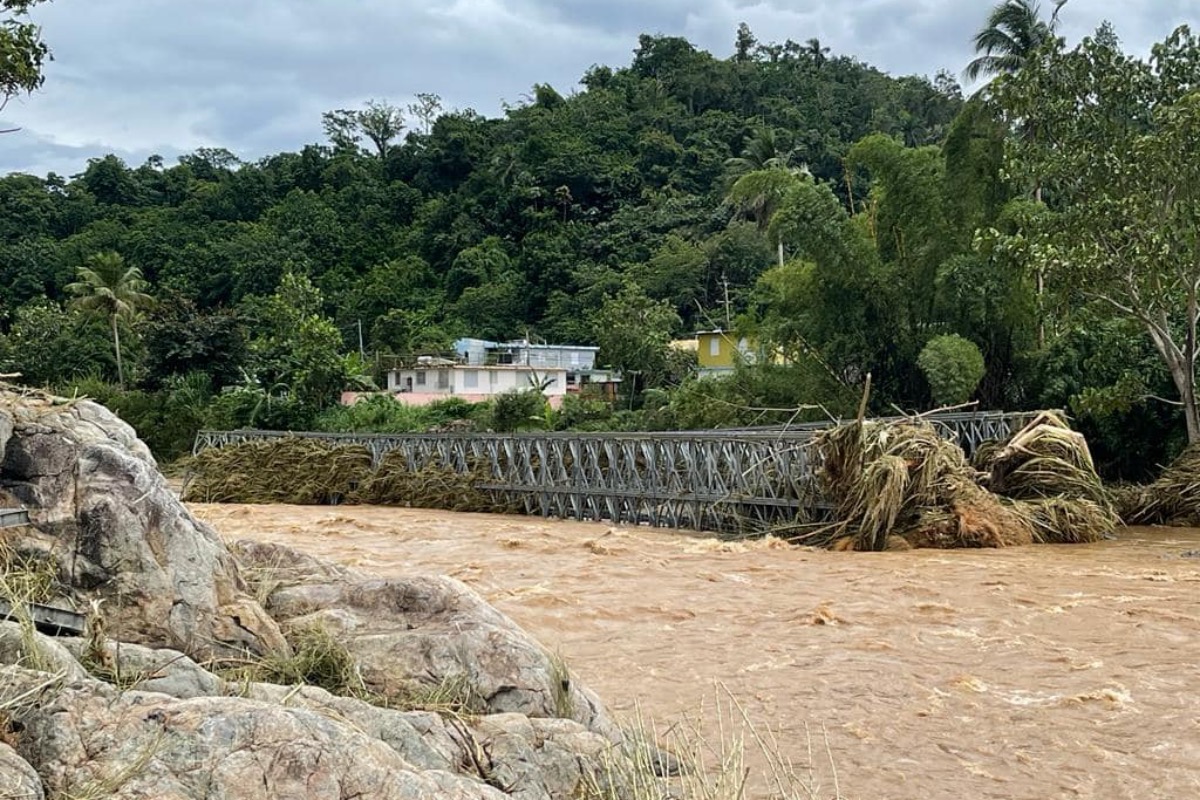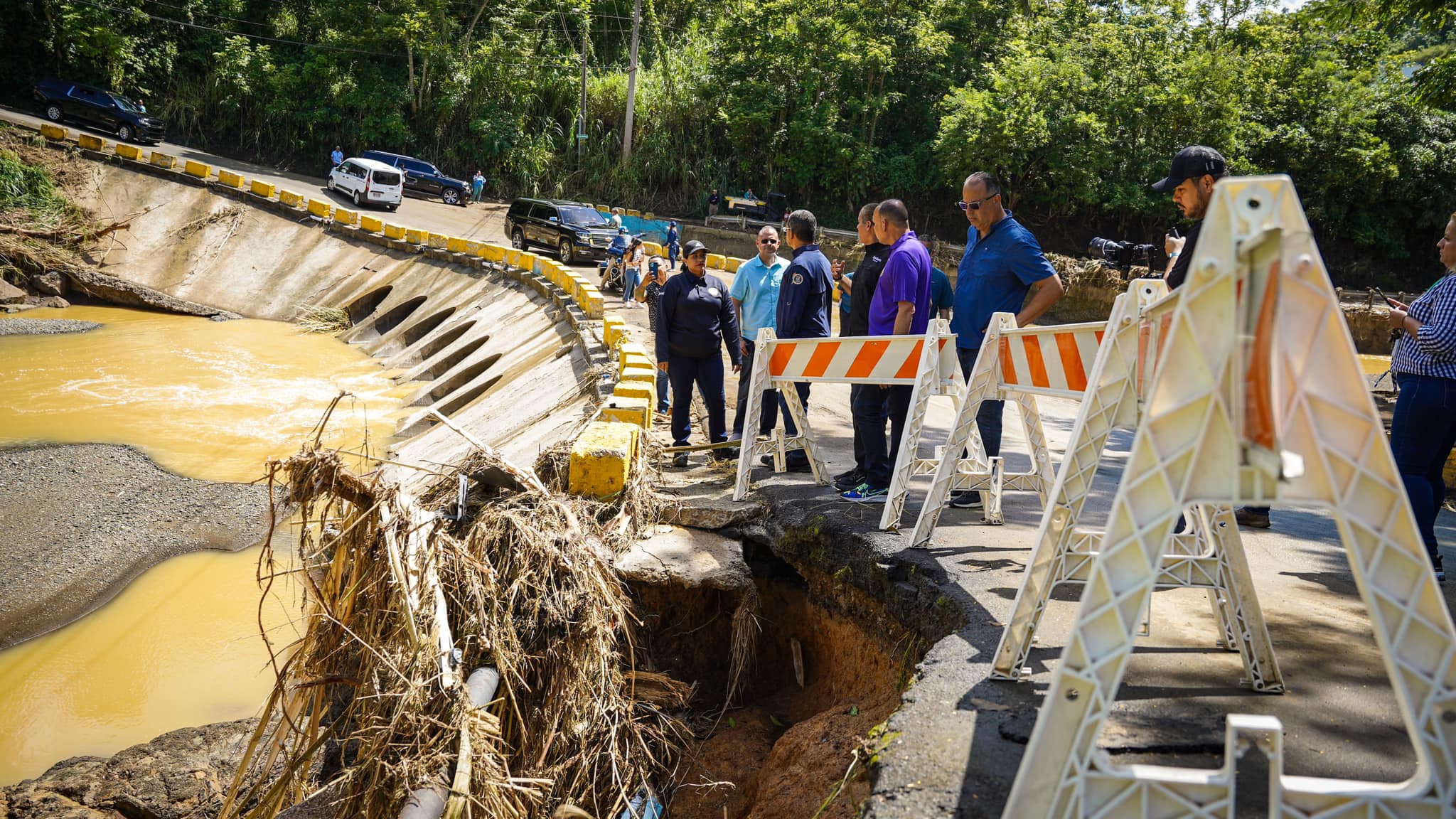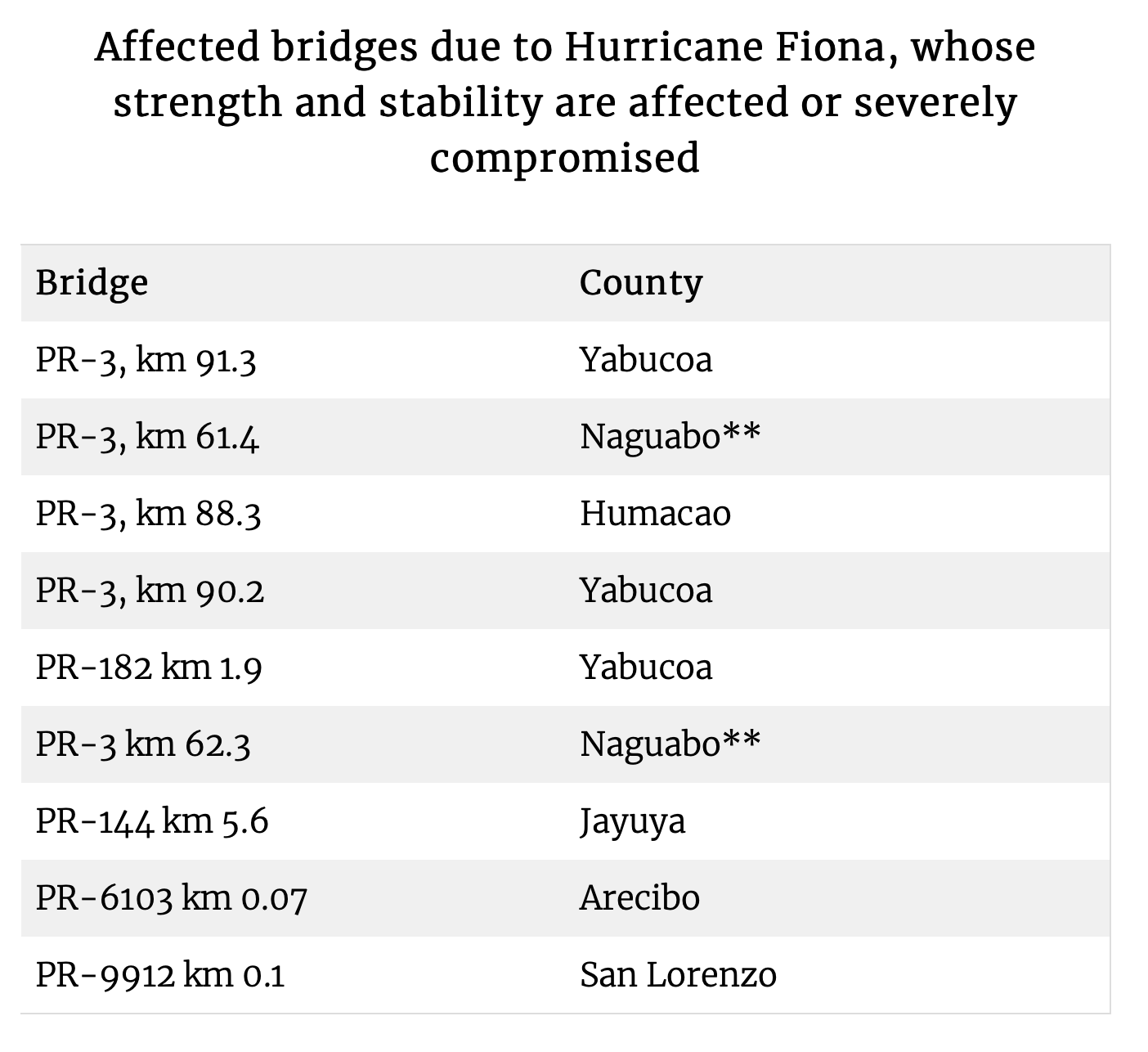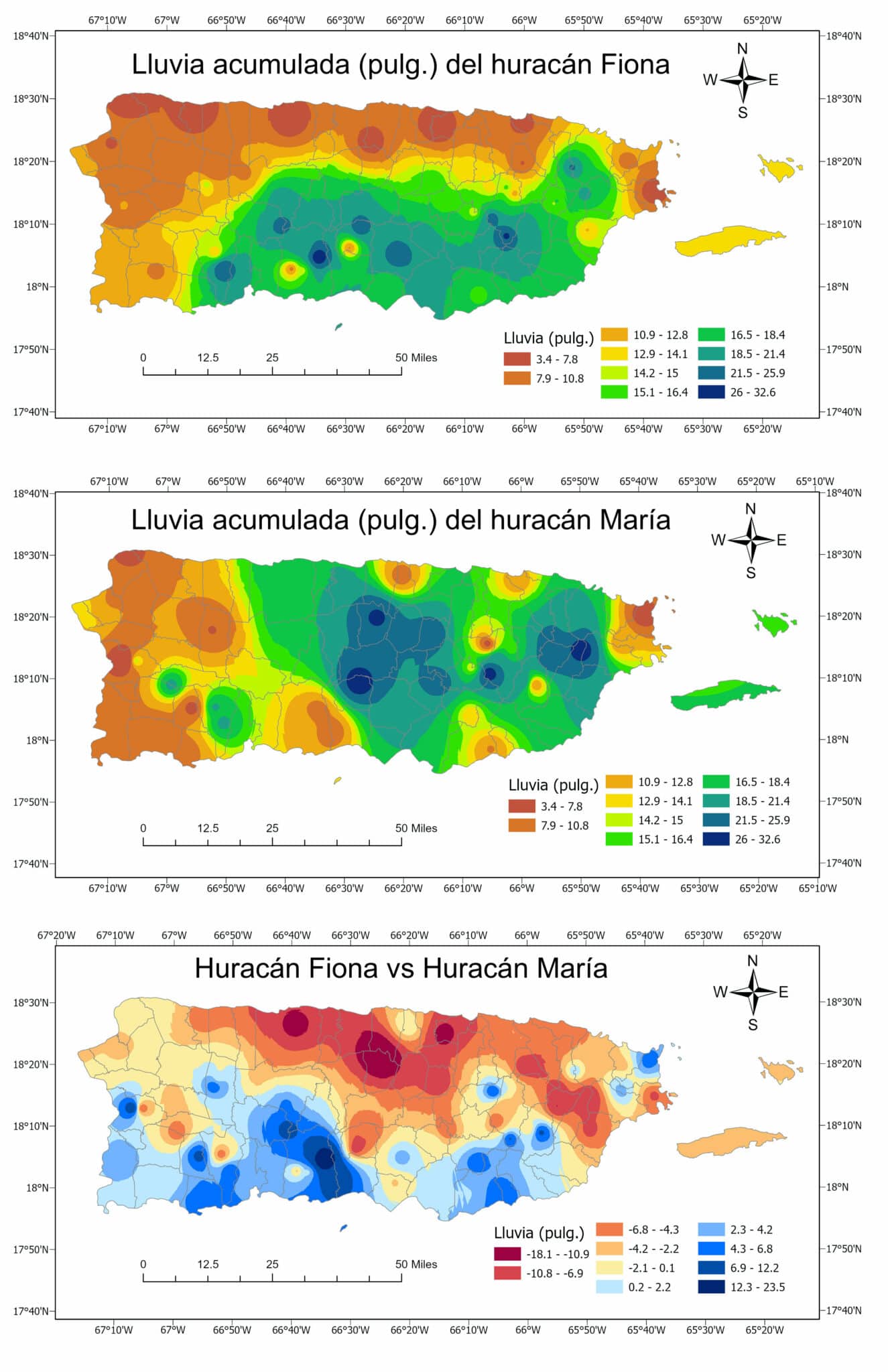

One of the bridges in Utuado completely collapsed as a result of Hurricane Fiona. (Utuado Municipal Government)
By RAFAEL R. DÍAZ TORRES, Centro de Periodismo Investigativo
SAN JUAN, Puerto Rico — The Department of Transportation and Public Works (DTOP, in Spanish) informed that 16 bridges suffered damage after Hurricane Fiona struck, but a Center for Investigative Journalism (CPI, in Spanish) investigation found that this number is wrong and that, from those 16, nine bridges had their strength and stability seriously or severely affected prior to the hurricane that hit Puerto Rico on September 18.
The CPI asked the DTOP where and which bridges were damaged because of Hurricane Fiona, and the agency sent a list that refers to only 16 bridges and eight ways to access those structures. However, a CPI review of videos and images published in the media and on social networks shows that the list that the government provided is incomplete.
The data that the CPI obtained indicates that there are dozens of bridges that collapsed or were undermined because of Fiona and that the DTOP did not include in the CPI’s request for information. Some of these bridges are located on municipal roads, as was the case of the crossing bridge in the Guaraguao sector in Bayamón. The crossings are small road structures that are built on shallow bodies of water, as is the case with some streams.
According to the DTOP, Fiona only affected three bridges in Yabucoa, two in Naguabo, two in Patillas, and one bridge in each of the municipalities of Arecibo, Cidra, Coamo, Humacao, Jayuya, Naranjito, San Germán, San Lorenzo, and Utuado.
According to the DTOP, in Utuado only one bridge on PR-6104 was affected, which according to the agency is the structure that collapsed with the flooding of the Río Grande de Arecibo, whose images went viral. Because of Fiona, in Utuado, of the 65 bridges and fords in Utuado, there are 44 bridges that need repairs.
It is not the first time that the DTOP and its Highways and Transportation Authority (ACT, in Spanish) withheld information about the bridges affected by the onslaught of a hurricane, especially those located on roads under municipal jurisdiction. In 2020, the CPI won an access to information case in which it asked the ACT for a list of bridges closed or affected by Hurricane María in September 2017.
Back then, the agency admitted in court that the list initially provided to the CPI did not contain all the bridges and that it had to add those municipal bridges that the CPI found in its independent search.


The collapse of a part of the bridge in Sector La Charca, in Aguas Buenas, caused the inability of families to communicate. (Government of Puerto Rico)
The list of bridges affected by Hurricane María that the ACT gave the CPI included only 32, even though a report financed by the federal government and signed by DTOP in 2018 indicated that 388 bridges were reported as having damage as a consequence of the storm, which represented an omission of 356 structures.
Infrastructure Undermined
The current U.S. National Bridge Inventory identifies seven bridges in Puerto Rico, from that list of 16 bridges informed by DTOP, as having “strength and/or stability of the bridge seriously affected” and two with “strength and/or stability of the bridge severely compromised.”
Most of these bridges affected by Fiona are located on road PR-3 and were already classified as “scour critical” before the hurricane. Specifically, the two bridges deemed as “severely compromised” are on road PR-3 in Naguabo. In the case of the seven bridges that were “seriously affected” before Fiona, three are in Yabucoa, two of which are on PR-3 and one on PR-182. The other three bridges with their stability seriously affected are located on: PR-3 in Humacao, PR-144 in Jayuya, PR 6103 in Arecibo, and PR 9912 in San Lorenzo.


**Bridges whose structure is severely compromised because of their classification as scour critical, according to NBI.
Source: DTOP, as of October 6, 2022 (National Bridge Inventory)
The bridge over the Limones River, on road PR-902 in Yabucoa, collapsed last week. According to the U.S. National Bridge Inventory, this bridge was classified as “seriously affected” and scour critical. This structure was not part of DTOP’s list of bridges affected by Fiona.
According to data from the National Highway Administration, only 17.4 percent of the bridges in Puerto Rico are in good condition. Of the island’s 2,335 bridges, 410 are identified as being in good condition, 1,613 appear to be in fair condition, while 312 are identified as being in poor condition.
The CPI asked the ACT if there was a monitoring plan for the bridges classified with a status of “serious condition” and “critical condition” prior to Hurricane Fiona according to the U.S. Department of Transportation’s standards. In addition, the ACT was asked if there is a plan to work with these bridges that are in a state of critical undermining, which is when the foundations of a bridge are weakened, making its capacity vulnerable. Neither the ACT Bridge Management Office nor any agency official answered any of the questions.
According to the Specifications for the National Bridge Inventory report, a bridge whose “stability is seriously affected” needs “frequent monitoring,” “load restrictions,” and “corrective actions.” Bridges with “severely compromised stability” need “significant load restraints,” and if not properly monitored, they could be closed until repaired.
Structural Civil Engineer Félix Rivera Arroyo believes that while a bridge in “serious condition” may still be used, it is essential that the government constantly monitor it, specifically the weight of the vehicles passing over it.
“Bridges are rated by tons. So, depending on the tons, that is the traffic you allow through it. There are some trucks that are very heavy. The government should watch the weight. It should constantly be monitoring and setting up monitoring stations to see if there is any kind of movement of the foundation of the bridge, so that the situation doesn’t worsen,” Rivera Arroyo told the CPI.
The expert, who also chairs the College of Engineers and Surveyors of Puerto Rico’s (CIAPR, in Spanish) Earthquake Commission, expressed concern about the permanence of several temporary bridges that were built more than two years ago to replace those structures that collapsed or were destroyed after Hurricane María in 2017. For example, one of the bridges that completely collapsed after Fiona’s was the temporary structure located in the Salto Arriba in Utuado, which had been installed four years ago at a cost of $762,800.
In a press conference held September 19, DTOP Secretary Eileen Vélez Vega, said the “temporary bridges have a life of up to 75 years.” Also, in 2019, the agency’s former secretary Carlos Contreras said these temporary bridges could last “many years,” defending the construction of this type of infrastructure as part of the recovery work after Hurricane María. However, Rivera Arroyo thinks differently.
“Those are temporary bridges, for one or two years, if any. But it’s now five years after María,” the engineer said.
Construction Code Amendments in the Pipeline to Solidify bridges
Puerto Rico’s current Construction Code establishes that the reference standard for the construction of bridges is the 100-year flood recurrence interval. This return period refers to the estimated time in which a storm with a given number of inches of rain is expected to occur in a region. The 100-year flood recurrence interval implies that, in average terms, that event should occur once every 100 years.
Although the number of inches of rain associated with the 100-year event varies by municipality and region in Puerto Rico, the truth is that, in just five years, there were places where approximations to those amounts were reported, both due to Hurricane María, and Hurricane Fiona, in a five-year period between events.
“In the case of Ponce, when we take it to three days [after Hurricane Fiona], it’s still within a 50-year rain event, almost approaching 100 years. A 50 [year event in that area] is 27.7 inches, and it dropped almost 32 [inches]. It was two inches short of being a one-in-100-year event,” climatologist José Javier Hernández Ayala explained to the CPI.
The researcher from Sonoma State University in California pointed out that in areas of Caguas, inches of rain fell equal to a 200-year return period, while in sectors of Utuado there were amounts associated with a 50-year rain event.


Prepared by Dr. José Javier Hernández Ayala, associate professor at Sonoma State University, physical geographer and climatologist
“Only five years passed between María and Fiona. What we’re seeing is that in return periods of extreme rainfall and river discharge, what used to be a one-in-100-year event is now a one-in-50. What was a one in 50 years, now it’s one in every 20,” said Hernández Ayala, referring to the fact that there were places where these extreme rain events occurred, both for the 2017 hurricane, and this year.
In the 19 years between Hurricane Georges in 1998 and Hurricane Maria in 2017, rainfall events equivalent to a 500-year return period were reported. For example, up to 20 inches of rain were recorded during Georges in areas of Caguas. That number, which corresponds to the inches expected in a rain event once every 500 years, was repeated in Caguas during María, Climatologist Amílcar Vélez said.
This frequency of extreme weather events should be a reason not only to reevaluate the averages of rain that are currently associated with different rain return periods, but also to change the current standard in bridge construction, Hernández Ayala said.
“An analysis of the entire island is needed to identify where the most significant river discharges are happening, how they are behaving in terms of their magnitude, how often these extreme events are occurring, and perhaps we can design [the bridges] for the worst case scenario. Perhaps the area that is most in need of more robust and resilient infrastructure is in Utuado, for example, but if we use those parameters and apply them to the entire island, one would think that other [bridge] areas [can] be protected,” said the also collaborator of the Puerto Rico Climate Change Experts and Advisors Committee.
Engineer Rivera Arroyo agreed with climatologist Hernández Ayala’s proposal as to the changes in the standards for bridge construction in Puerto Rico. Rivera Arroyo represents the CIAPR in the committee that evaluates the changes to the Puerto Rico Construction Code.
Rivera Arroyo said the new version of the Code should be ready between February and March 2023. One of its proposals will be to change the bridge construction standard so that it is based on rainfall that responds to the return period of 200 years, instead of 100 years as it is now. This proposal is based on the acknowledgment that extreme rainfall events in Puerto Rico are becoming more frequent.
“We have the power to revise the Code that we use. In the 2018 [Construction Code] the 100 years are mentioned, but we can change that for Puerto Rico, given the situation and conditions that we have. The codes establish minimum parameters. You will never be 100 percent protected, but [amending it] will help deal with future events,” said Rivera Arroyo, who warned that construction costs will increase with the changes to the Code.
Multimillion Dollar Change Orders
The ACT has signed contracts and amendments for almost $218 million under the category of Road Construction and Repair in 2022, according to the Office of the Comptroller (OCPR, in Spanish).
Those contracts include works on the bridge over the Yagüez River, and on the bridges between Sabana Grande and Guánica, improvements to the bridge over the Guanajibo River on PR-2 in San Germán, replacement of the bridge over the stream on PR-3 in Ceiba, improvements to the bridge on PR-681 in Toa Alta and preservation work on a bridge in Utuado on PR-10 between km 39.60 and 39.10. There was also the rehabilitation of a cable of the suspension bridge over the La Plata River, between the municipalities of Naranjito and Toa Alta.
The ACT also signed about 10 contracts that extend the term of several projects to be carried out in bridges through 2024. In those cases, although it was not a new bid, instead of amending the original contract to extend the term, the public corporation wrote up a new contract with a different number, which corresponds to a project assigned between five and 10 years ago and whose project completion period has expired.
The extension of the term to complete projects whose original contracts expired a long time ago is not exclusive to bridge works but also to other types of projects on public roads. For example, on September 29, the ACT signed a contract to extend to L.P.C.&D. Inc. the term for a project on PR-778, in Comerío, which was assigned in 2003 and whose validity was until 2014.
The contract signed in September 2022 shows that the project is done or substantially finished, but that there is an outstanding amount of $339,010 and it is necessary to extend the agreement for two more years due to the delays caused by the COVID-19 pandemic. So, this contractor has had control of the projects on the Comerío highway for 19 years.
The ACT’s contract registry shows agreements under the category of Construction and Repairs of roads that have dozens of change orders that have increased the original amount of the contracts by millions. For example, last March, the ACT signed amendment number 63 to a contract awarded in March 2012 to contractor L.P.C.&D. Inc. for projects on three roads in Fajardo. The change orders establishing these amendments added $5.5 million to the original contract of $14.4 million.
Last June, the ACT approved amendment number 56 to a contract that it awarded to Ferrovial Agroman in March 2014 for improvements to PR-18 and PR-21. The amendments added $1.7 million to the original $16.1 million contract that originally expired in 2017.
Meanwhile, between September 19 and October 19, 2022, the ACT awarded 20 emergency contracts to address the damage caused by Hurricane Fiona in the five regions—north, south, east, west, and San Juan metro. With master contracts for $200,000 and $400,000, the projects were distributed among 20 contractors by geographic region. Agreements have already been signed with eight companies to serve the northern region, four for the southern and eastern regions, three for the western region, and one for the San Juan metropolitan area.
Federal Funds Allocated to Repair Puerto Rico’s Bridges and Roads
In November 2021, US President Joe Biden signed the Bipartisan Infrastructure Act to provide $550 billion between 2022 and 2026 for projects such as roads, bridges, and water infrastructure, among others.
In the case of Puerto Rico, it is projected the island will receive about $1.1 billion to improve the condition of roads and bridges during those five years. Part of the federal government’s justification for authorizing this allocation is that 282 bridges and more than 1,492 miles of roads are in “poor condition,” according to what the CPI read in a document from the U.S. Department of Transportation.
The Bipartisan Infrastructure Act aspires to “repair and rebuild our roads and bridges with a focus on climate change mitigation, resiliency, equity, and safety for all users, including cyclists and pedestrians.”
—
Reporter Wilma Maldonado Arrigoitía contributed to this story.


